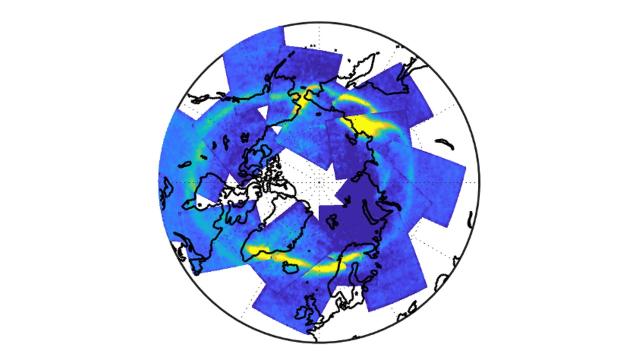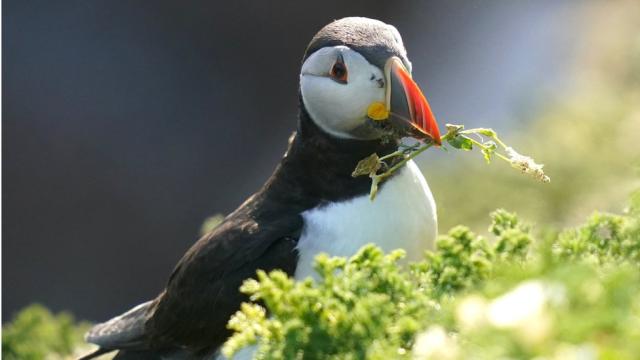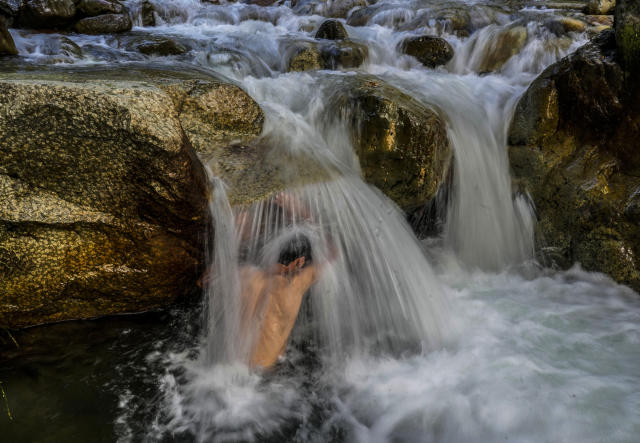Science Daily News | 06 Jul 2023

Views (119)

Satellites uncover 'invisible' auroras glowing in infrared in Earth's atmosphere
Scientists have observed an aurora glimmering in infrared light, created by the interaction of energetic cosmic particles and carbon dioxide in Earth's atmosphere.

Is an aurora still as impressive if its invisible?
Observing auroras from space has some distinct advantages; from the ground, scientists can't see auroras during the daylight, and they're limited in how much of the sky any one telescope can cover. AIRS, on the other hand, has been observing infrared energy — including that from the aurora — every day for years. This data set covers over 20 years, and will be invaluable to future studies of the aurora. "It's very exciting to have a view of the aurora in a different way," says Bossert.
Auroras are an important window into Earth's atmosphere for scientists, and there's still a lot we don't know about how the cosmic environment interacts with the upper layers of our atmosphere.
Studies like this give scientists a better picture of "when and where auroral activity is happening," says Öztürk. They're also trying to figure out "just how far energetic particles can make it into Earth's atmosphere," says Bossert. It's still unknown how the carbon dioxide aurora varies with seasons, too, which may relate to fluctuations in the levels of carbon dioxide in the atmosphere.
RELATED STORIES:
In addition to the big data set, Bossert and team did reveal a new bit of information about the upper atmosphere: That the energetic particles funneled towards Earth by our magnetic field deposit their energy by smacking into carbon dioxide molecules.
The planet saw its hottest day ever this week. The record will be broken again and again
This week saw the hottest global temperature ever recorded, according to data from two climate tracking agencies.

“It’s not a record to celebrate and it won’t be a record for long, with northern hemisphere summer still mostly ahead and El Niño developing,” said Friederike Otto, senior lecturer in climate science at the Grantham Institute for Climate Change and the Environment in the UK.
This year has already seen heat records broken around the world, with devastating consequences.
“Alongside natural variability, the background warming of the Earth’s atmosphere due to human induced climate change has driven up the possibility of reaching record high temperatures,” Paul Davies, Met Office climate extremes principal fellow and chief meteorologist, said in a statement.
The new global average temperature record is another wake-up call, Otto told CNN. “It just shows we have to stop burning fossil fuels, not in decades, now. This day is just a number, but for many people and ecosystems it’s a loss of life and livelihood.”
Nearly half of the tap water in the US is contaminated with ‘forever chemicals,’ government study finds
Almost half of the tap water in the US is contaminated with chemicals known as “forever chemicals,” according to a new study. The number of people drinking contaminated water may be even higher than what the study found, however, because the researchers weren’t able to test for all of these PFAS, chemicals that are considered dangerous to human health.

The number of people drinking contaminated water may be even higher than what the study found, however, because the researchers weren’t able to test for all of these per- and polyfluorinated alkyl substances, or PFAS, chemicals that are considered dangerous to human health.
The scientists collected water samples directly from taps at 716 locations – 269 from private wells and 447 from public sources – between 2016 and 2021. Based on their findings, they estimate that at least one PFAS chemical would be detected in 45% of US drinking water samples.
Most of the contamination came from water sources near urban areas and in areas that generated PFAS, like manufacturing that uses the chemicals in its products or sites where waste was collected.
The highest concentrations of PFAS in drinking water were found in the Great Plains, the Great Lakes, the Eastern Seaboard and Central/Southern California, the study said.
Concentrations were similar between private wells and public supplies.
PFAS can be found in many places, studies show, so toxicologist Dr. Jamie DeWitt is not surprised that it is in so much drinking water.
PFAS are found in hundreds of household items. The chemicals are used to make carpets and clothes stain-resistant. They keep food from sticking to pans and food packaging, and they’re good at keeping grease and water from soaking through. PFAS are in mobile phones, commercial airplanes and low-emission vehicles, in the foods you can buy at the farmers market or the grocery store, and in rainwater and dental floss. They’re even in the dust that collects in your home.
“I think that’s still a pretty high number, considering,” she said.
DeWitt said that it’s important for people to know what’s in their drinking water but that they don’t necessarily need to be scared.
“I don’t think people should be afraid, but they should be aware and armed themselves with knowledge so that they can get information that will help them to make decisions,” she said.
She recommended looking at your local utility website to get its most recent water report. Utilities will disclose what’s in the water and what they are doing to reduce contaminants.
A carbon filter can help, but it has to be changed regularly. If used too long, the filter can become saturated with chemicals and not work as well. Households can also use reverse osmosis filtering systems, but those can be expensive.
If the standards are finalized, water systems will have to determine whether levels of these PFAS pose a potential risk. They may also need to install treatment or take other actions, the EPA said, and may even need to switch to different water sources.
If PFAS is in 45% of US water systems, the country will have a lot of work to do, said Dr. Graham Peaslee, a professor in the Department of Physics and Astronomy and concurrent professor of chemistry and biochemistry who does PFAS research at the University of Notre Dame.
“I think that we should try our best to work on how to clean this up. My fear is that this is, global warming aside, this is probably the most expensive environmental problem we’re ever going to face,” said Peaslee, who was not involved in the new study. ”There’s nothing that will magically fix it. It’s fairly expensive to clean this up. And it’s a recurring cost, and there’s no permanent solutions to it for any particular utility. It looks frightening.”
But the cleanup will have to be done, he said, because these chemicals carry real health consequences, and people can’t exactly avoid drinking water.
“It’s really insidious, this poison,” Peaslee said. “We are going to have to get inventive on how to filter it out for all of our days.”
Puffins: Rats and ferrets targeted to protect Rathlin Island seabirds
New project bids to rid Rathlin of non-native predators threatening the seabirds' future.

Think of Rathlin Island and you most likely think of puffins.
But with numbers declining by 40% since 1999, the race is on to protect the colourful ground-nester from predators before the balance tips.
Now, in a world first, a new project will see ferrets and rats trapped to eradicate non-natives from the island.
After a year of preparation, 450 traps with wireless monitoring and 6,000 bait stations are being laid all over the island from this winter.
The aim is to have all ferrets and rats removed by 2026, restoring the island to a safe haven for internationally significant breeding seabirds.
As well as puffins, there are razorbills, kittiwakes, Manx shearwaters, guillemots and fulmars.
Monitoring will continue beyond the five-year £4.5m the LIFE Raft project to maintain biosecurity.
Rats most likely arrived on boats more than a century ago.
But ferrets, voracious and efficient hunters, were released deliberately to control the rabbit population.
Both species quickly turned their attentions to the seabirds and their young.
They are now all over the island and RSPB warden Liam McFaul is worried that matters are at a tipping point.
He said without some control mechanism to control the predators, there could be a day when hardly any puffins will be left on Rathlin.
He has lived his whole life on the island and has monitored seabirds here for more than 30 years with the RSPB.
"I can't imagine the day that there wouldn't be any of these seabirds or a real big shift in numbers of the population.
"Rathlin's such a strategic and important nesting site for the seabirds because it's an off-shore island and in that case should be safe," he said.
A team of people, like conservation scientist James Crymble, has spent the year surveying the island and training in preparation for what is a mammoth undertaking.
"Rathlin is actually quite a big island and it's quite a diverse island as well, there's lots and lots of different habitats, different terrain. The weather's pretty mean and it's going be a huge job," he said.
"The best way to do it is to lay out a grid across the whole island."
That entails laying a trap every 250m, the range an individual ferret will cover.
Everywhere will need to be targeted, said James, including grassy ledges scattered down the cliffs - an undertaking that requires some extreme training.
"There'll be a huge amount, obviously abseiling, rope access skills, off-roading skills, all terrain vehicles, obviously first aid, things like that.
"By the end of it we'll be an elite force."
He added: "And all of that will take place during winter. So absolutely the worst time of year, really, for us walking around."
But winter is the best time to target predators, who will be getting hungry as their prey migrates from the island.
Protecting the seabird population is also about protecting people.
The economy on the island relies on thousands of visitors who come here every year for the wildlife.
So while conservation like this - destroying one species to protect another - can be controversial, people on Rathlin are wholeheartedly behind the project.
"The island resident population have started to catch on to this," said Michael Cecil, chair of the Rathlin Development and Community Association.
"There's more and more interest from around the world, from scientific communities and other islands that are interested in similar things. So yeah, we're starting to pick up a bit of notice, more and more so and islanders are starting to talk about this project."
Similar projects have been undertaken on the Isles of Scilly, in the Shiants off Scotland and, most recently, on Gough Island in the south Atlantic
But this is the first time that ferrets will be targeted as part of a conservation effort like this.
"It's not cheap to get rid of these animals, but it's hugely beneficial for the wildlife here," said James.
"Nature is in crisis. We're looking at climate change. We're looking at overfishing at sea and this is the best way to really protect the island for future generations and just give them a bit of a buffer zone to face these overarching global problems."
It will take time for the populations to recover, but at the upside-down lighthouse that is home to Rathlin's Seabird Centre, Liam McFaul is hopeful.
"Seabirds are a very long-lived species and you're taking out the predators. You're not going to just immediately see next year lots and lots more birds, it'll take a number of years for them to build up.
"Rathlin is an internationally important mixed seabird colony. There's 150,000 guillemots and 22,000 razorbills, that's just literally breeding birds sitting on the cliffs.
"When you look on the sea, that's just peppered with birds and you look in the air, they're flying all over the place.
"So a census of these birds only takes consideration of what's sitting on eggs and on the cliffs. There's thousands and thousands more that's not counted.
"So lots and lots of monitoring will be done over the next few years, to see the changes from the predators being taken out."
Tuesday set an unofficial record for the hottest day on Earth. Wednesday may break it.
The planet's temperature spiked on Tuesday to its hottest day in decades and likely centuries, and Wednesday could become the third straight day Earth unofficially marks a record-breaking high. The globe's average temperature reached 62.9 degrees Fahrenheit (17.18 degrees Celsius) on Tuesday, according to the University of Maine’s Climate Reanalyzer, a common tool based on satellite data, observations, and computer simulations and used by climate scientists for a glimpse of the world’s condition. On Monday, the average temperature was 62.6 degrees Fahrenheit (17.01 degrees Celsius), setting a record that lasted only 24 hours.

For scientists, it’s a sweaty case of I-told-you-so.
Even normally cooler communities are feeling the heat. In North Grenville, Ontario, the city turned ice-hockey rinks into cooling centers as temperatures Wednesday hit 90 degrees Fahrenheit (32 degrees Celsius), with humidity making it making it feel like 100.4 degrees (38 degrees Celsius).
“I feel like we live in a tropical country right now,” city spokeswoman Jill Sturdy said. “It just kind of hits you. The air is so thick.”
THE RECORD HIGHS ARE UNOFFICIAL BUT SIGNIFICANT
University of Maine climate scientist Sean Birkle, creator of the Climate Reanalyzer, said the daily figures are unofficial but a useful snapshot of what’s happening in a warming world. Think of it as the temperature of someone who's ill, he said: It tells you something might be wrong, but you need longer-term records to work like a doctor's exam for a complete picture.
While the figures are not an official government record, “this is showing us an indication of where we are right now,” said National Oceanic and Atmospheric Administration chief scientist Sarah Kapnick. And NOAA indicated it will take the figures into consideration for its official record calculations.
Even though the dataset used for the unofficial record goes back only to 1979, Kapnick said that given other data, the world is likely seeing the hottest day in “several hundred years that we’ve experienced.”
Scientists generally use much longer measurements — months, years, decades — to track the Earth’s warming. But the daily highs are an indication that climate change is reaching uncharted territory.
JUST HOW HOT IS IT?
High-temperature records were surpassed this week in Quebec and Peru. Beijing reported nine straight days last week when the temperature exceeded 95 degrees Fahrenheit (35 degrees Celsius). Cities across the U.S. from Medford, Oregon, to Tampa, Florida, have been hovering at all-time highs, said Zack Taylor, a meteorologist with the National Weather Service.
Alan Harris, director of emergency management for Seminole County, Florida, said that they’ve already exceeded last year in the number of days they’ve had their extreme weather plan activated, a measure initiated when the heat index will be 108 degrees Fahrenheit (42.22 degrees Celsius) or greater.
“It’s just been kind of brutally hot for the last week, and now it looks like potentially for two weeks,” Harris said.
SOME POPULATIONS ARE AT RISK, BUT MANY ARE STILL OUTDOORS
“People aren’t used to that. Their bodies aren’t used to that,” said Erinanne Saffell, Arizona’s state climatologist and an expert in extreme weather and climate events. “That’s important to understand who might be at risk, making sure people are hydrated, they’re staying cool, and they’re not exerting themselves outside, and taking care of those folks around you who might be at risk.”
Overall, the heat means something a little different to everyone.
In West Texas, it’s cool wraps and Gatorade for construction workers, said Joe Staley, a job site superintendent for a company that builds wastewater treatment plants. In Portland, it’s extra water on backyard vegetable gardens, said Martha Alvarado. In Minnesota, it’s a difficult workout on the family vineyard thanks to extra humidity for Joe Roisen.
In Dallas, the heat also means a sense of camaraderie for musician Sam Cormier, who often plays outdoors. Apartment dwellers with their windows open step out to bring him a drink. People are still walking around outside, even with the weather, and he plays with just his guitar, which is lighter than other equipment. He’d rather be outside sweating, he said, than inside on a computer.
HOW WE GOT HERE, AND WHERE WE'RE GOING
“Not all records are meant to be broken. In almost every corner of our planet, people are facing the brunt of unprecedented heat waves,” said United Nations Environment Programme Director Inger Andersen. “We ignore science at our own peril. ... It is the poorest and most vulnerable that continue to suffer from our inaction.”
Wednesday may bring another unofficial record, with the Climate Reanalyzer again forecasting record or near-record heat. Antarctica's average forecast for Wednesday is a whopping 4.5 degrees Celsius (8.1 degrees Fahrenheit) warmer than the 1979-2000 average.
Because humanity hasn’t stopped pumping heat-trapping gases into the air, future generations will look back at the summer of 2023 as “one of the coolest of the rest of your life,” said Texas A&M climate scientist Andrew Dessler.
___
Borenstein reported from Washington and Walling from Chicago.
___
___
___
James Webb Space Telescope spots the wreckage of a cosmic clash of the Titans (image)
The James Webb Space Telescope has spied a distant galaxy that represents the wreckage of a titanic collision between two galaxies 500 million years ago.

A new image from the James Webb Space Telescope (JWST) shows that when it comes to galaxies, appearances can be deceiving.
The historic merger that created NGC 3256 is also responsible for an intense burst of star formation in the galaxy. This happens because when galaxies collide, they channel gas and dust together into dense clouds to become the raw material needed for star birth.
Related stories:
When galaxies collide, most stellar bodies escape the violent collisions unscathed, unlike the gas and dust content of those galaxies. That's because of large voids between stars. But it isn’t the case for all the stars in those galaxies. Visible in the JWST image of NGC 3256 are threads of stars that were wrenched free of their home galaxies as a result of gravitational interactions between the colliding galaxies giving rise to incredible tidal forces.
The stunning image of this galaxy was created by the JWST using data from its Near Infrared Camera (NIRCam) and its Mid-InfraRed Instrument (MIRI). Visualizing NGC 3256 in this way demonstrates the usefulness of the JWST, the most powerful telescope ever placed into orbit around Earth, in understanding the growth of galaxies and the evolution of the universe.
0 Likes
